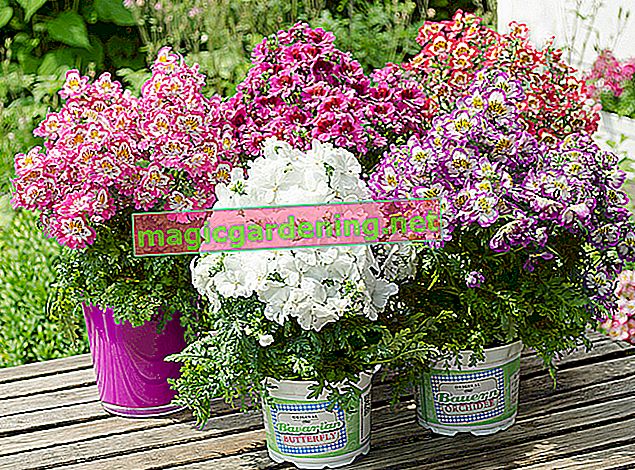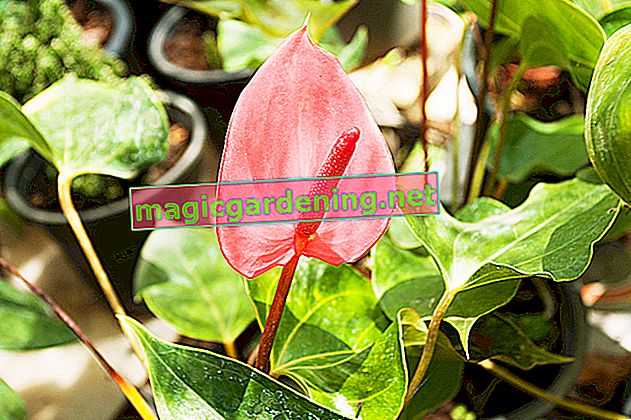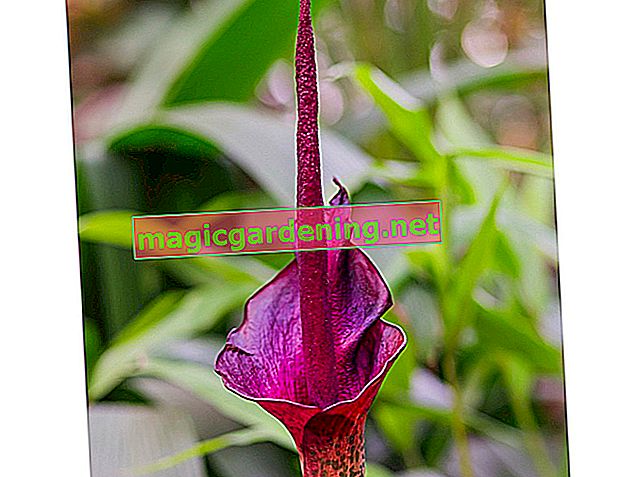
origin
The farmer orchids originally come from South America, where they grow in the coastal regions of Chile. Its area extends from Antofagasta in the north to Lake Llanquihue in the south. Two of the twelve species within this genus managed to spread over the high mountain regions of the Andes to Argentina. These types are characterized by particularly robust properties. Farmer orchids have been transported to different parts of the world by boat trips, where they are cultivated as annual plants.
also read
- Caution: the farmer's orchid is poisonous!
- Extend the flowering time of the farmer's orchid
- The farmer orchid is not perennial, but annual
blossom
The herbaceous plants develop flowers with five petals that are mirror-symmetrical. One petal protrudes forward, while two lean to the side. The two rear petals are fused into a boat and bent backwards. Each flower stands on a flower stalk that bends back over the course of the growing season. When the plants are in full bloom, the flower stalks are rotated 72 degrees. Unlike other nightshade plants, farmer orchids develop free-standing sepals.
The flowering period extends from spring to late summer, with the plants blooming several times. Farmer orchids are rarely pure white in color. The color palette of the flowers is broad and ranges from red to yellow to blue and black. They can appear monochrome or multicolored. Different colored specimens develop eye-catching drawings in the flower center. A yellow-black colored flower eye is typical. Single-colored cultivated forms have pink, red or white shades of color. The color strength of the farmer orchids is intense and is characterized by high luminosity.
fruit
The plants develop egg-shaped capsule fruits, the tips of which are blunt or rounded. One fruit contains between twelve and 34 seeds that are only two millimeters long. The fruits can be up to ten millimeters in size. They develop several times a year. The first fruit ripening takes place in May. The last fruit development occurs in September.
leaves
Farmer orchids develop finely structured foliage, which lies flat over the substrate. The leaves are severely incised, creating a feathery appearance. The sections have a roughly serrated leaf edge. The leaves grow between three and nine inches long. With their luscious, shiny green they create an aesthetic contrast to the brightly colored flowers. The leaves wither in autumn.
growth
The majority of farm orchids grow as an annual. The plants rarely grow over two growing seasons. The ornamental plants are grown as annuals. They partially lignify at their base and grow between 25 and 100 centimeters high. The entire plant is sticky because the surfaces of the leaves, stems and flowers are covered with glands that produce a tough secretion.
Is farm orchid poisonous?
Farmer orchids contain a high proportion of various alkaloids that cause poisonous effects after consumption. The chemical compounds are nitrogen-containing organic substances that are secondarily formed by plants in certain cells. All plant parts of the farmer orchid have alkaloids, which have a strong effect on the organism of animals even in small doses. In humans, they cause stomach and intestinal complaints that can lead to nausea, vomiting and diarrhea.
Continue reading
use
Annual plants have been popular ornamental plants since the advent of cottage gardens. They decorate balconies and terraces mainly during Easter. Peasant orchids decorate tables and benches in entrance areas and create a spring-like atmosphere next to front doors and on stairs. They create a wild character and enchanted oases in the garden. The ornamental plants are ideal for rural, rustic themed gardens.
The ornamental plants, also known as slit flowers, are suitable for indoor and outdoor use. Farmer orchids can be grown as solitary plants in pots. They thrive in small groups in the garden bed under trees or in the open, unshaded area. They work particularly well in the vicinity of flowering hedges and bushes. Pfaffenhütchen and cornel cherries are ideal plant partners. Farmer orchids harmonize with candytufts, loyal men, mallows and daisies.
Which location is suitable?
Make sure you have a sheltered location away from the wind. Farmer orchids like a place with sunny conditions. Even in a partially shaded location, the flowers are lush if the care conditions are right. Shady locations are possible, but ensure less flower development.
If you cultivate your orchid in a bucket, entrance areas, terraces and staircases provide ideal locations. In the open air, the plants like to grow under trees or with a good water supply in full sun.
What soil does the plant need?
The plants prefer a well-drained substrate with a high proportion of humus. Compost soil or manure are ideal for enriching the soil. The soil should be well drained so that no waterlogging occurs. You can mix heavy soil with sand to improve soil properties for the farmer orchid.
sowing
Scatter the seeds on the earth. Farmer orchids are light germs. Make sure that the seeds are not covered in soil. Wet the seeds evenly with water. Use a spray bottle for this, as vigorous watering would float the soil up and the seeds would float in dammed moisture. Wrap a translucent fleece around the planter so that the humidity remains constant. Ventilate once a day to prevent mold growth.
Place the planter in a bright location with temperatures between 20 and 25 degrees Celsius during the day. At night, temperatures should not drop below 18 degrees Celsius. Make sure that the planter is in a sheltered place. Under optimal conditions, the seeds will begin to germinate after three days. It usually takes seven days for the first signs of germination to show.
What is the best time to plant?
Young plants grown in March are ready to be planted outdoors between April and May. Plants that you preferred in autumn can be moved into pots as early as mid-March and placed in a protected place. If you want to sow the seeds directly in the bed, you can start doing so in March.
The correct planting distance
Don't plant farmer orchids too closely. The ornamental plants need space to each other outdoors so that the leaves can dry off quickly after a downpour. Stands that are too dense promote a moist microclimate in which fungal spores find optimal growth conditions. A distance of at least 20 centimeters to the next planting partner is ideal.
balcony
Farmer orchids are ideal plants for the balcony. Here they thrive in the balcony box. Cultivated as a container plant, they are perfect for the early decoration of balconies. From March you can put the farmer's orchid on the balcony. The plant can withstand temperatures down to -7 degrees Celsius without problems.
In the greenhouse
Greenhouses (€ 34.95 at Amazon *) are ideal for growing the seeds, as they guarantee high and constant humidity. Here you can sow seeds in autumn that you have collected yourself or that you purchase from specialist shops. Make sure you put the greenhouse in a consistently warm place. As soon as the young plants have grown about an inch high, they should be moved to larger planters. If you have a sufficiently large greenhouse, there is no need to move. In the following spring, the plants are ready to be planted in pots or outdoors.
Farmer orchid in a pot
Farmer orchids are ideally suited for cultivation in the tub. The vessels can be put outside early in the year. The plants are adapted to fluctuating temperatures and have no problems with late frosts.
Propagate farmer orchids
The seeds, which develop several times a year, are suitable for propagating annual plants. However, not every cultivated form produces germinable seeds. You can find out by sowing the seeds in damp soil and observing. Let the faded flower stems stand so that the fruits can ripen. Since the seeds are a few millimeters in size, collecting them requires a certain amount of dexterity. Alternatively, you can purchase seeds from stores.
The seeds keep their ability to germinate for several months, so you can store them before sowing. Make sure you keep it in a cool and dry place, as warm temperatures and moisture encourage the seeds to germinate. Collect the seeds in a paper bag.
Cut the farmer's orchid correctly
After the first blooming phase in May, pruning vigorously encourages the development of a second bloom. Separate the withered flower stems. Farmer orchids can be cut back by two thirds. The plant develops numerous side shoots on which new flowers appear. If you want to propagate the plant, you should wait until the fruit ripens before pruning the stems. Cut withered leaves regularly to prevent rot.
You can remove dead flowers all year round. A final pruning takes place in August. The plant will keep developing new shoots until the last flowers have wilted in September. After heavy rainfall, be sure to cut off any broken stems. This will prevent the plant parts from rotting between the fresh shoots.
Use sharp secateurs to prevent the fabric from tearing when you cut. Small wounds provide a good breeding ground for fungal spores when the conditions are very humid.
Fertilize farmer orchids properly
Farmer orchids have a high energy requirement, which increases when the flowers are developing. Fertilize the plants every two weeks. This supply of nutrients leads to a lush flower development, so that the leaves of the plant are barely recognizable under the flowers. Use balcony flower fertilizer or liquid fertilizer that has been enriched with guano (€ 10.44 on Amazon *).
Young plants do not need fertilization. The plants should be at least eight weeks old when they are first fertilized. After vigorous pruning, farmer orchids need additional fertilization so that they can regenerate quickly.
Water the peasant orchid
The ornamental plants are characterized by a high water requirement. Never let the soil dry out completely and keep the soil evenly moist in the bucket and outdoors. Farmer orchids do not tolerate waterlogging, which is why the planter should have a drainage hole. Only water potted plants over the saucer. Outdoor plants are watered at the base. Farmer orchids are extremely sensitive when the flowers get wet. They look ugly after a rain shower, as the petals hang limply. Heavy rainfall can cause flower stems to break off. The plants usually regenerate quickly.
Prick out
After about two weeks, the young plants are transplanted from the growing container into a larger pot. You should be at least an inch tall. When the plants are ten centimeters, you can cut off the tips. This will encourage bushy growth.
Fungal attack
Farm orchids can be attacked by fungi if the conditions are too humid. Waterlogging is one of the most common causes of fungal diseases. When the roots rot, spores find an ideal breeding ground and spread. The roots can no longer draw enough nutrients and water from the soil, so that the flowers decrease and the plant wilts.
Stands that are too densely planted favor a moist environment, as the plant is no longer adequately ventilated. Wilting leaves that have not been removed in time provide good growing conditions for the spores. Do not place the plants too close together in the bed and remove dead plant material regularly.
Pests
Because of the alkaloids they contain, farmer orchids are of no interest to pests. They are not attacked by aphids and are not an attractive source of food for snails and beetles.
Hardy
As an annual plant, you cannot overwinter the farmer orchid. After the crop has wilted in autumn, you can compost the leftovers. In spring, mature plants can tolerate temperatures that do not fall below -7 degrees Celsius. Young plants should be brought in. Otherwise there is a risk that the plants will be damaged by night frosts.
Continue reading
Tips
Cut the withered flowers as deeply as possible and shorten the side of the plants. Push the plants slightly to one side and mix some fresh compost into the soil. Water the plants vigorously. After three weeks, the farmer's orchid is in full bloom.
sorts
- Tinkerbell: Blooms in pink, light purple and white with yellow-black flower eyes. Flowering period between June and October. Reaches heights of between 50 and 60 centimeters.
- Compacta: Finely incised leaves. Flowers monochrome or multicolored with shades of red, yellow and white. Grows between 30 and 40 centimeters tall.
- Blunted split flower: Develops hand-sized flowers with star-shaped sepals. Pronounced growth with densely branched shoots and numerous flower clouds. Petals golden yellow with red veins, sepals bright red or pink. Blooms between July and September. Grows between 70 and 90 centimeters high.
- Pinnate split flower: flowers shine in light rose red, ruby red or dark purple. The flowering period extends through late summer. Grows up to 90 centimeters high.
- Hybrid split flower: Finely structured foliage. Flowers are colored red-white, cream-yellow, violet-yellow or in different shades of pink. Grows to a height of 80 centimeters.
 Dendrobium 'Berry Oda' 23.06 EUR Buy at baldur
Dendrobium 'Berry Oda' 23.06 EUR Buy at baldur  Phalaenopsis orchid, 2 shoots, 'Yellow' 15.65 EUR Buy at baldur
Phalaenopsis orchid, 2 shoots, 'Yellow' 15.65 EUR Buy at baldur  Royal blue Phalaenopsis, 2 shoots 27.42 EUR Buy at baldur
Royal blue Phalaenopsis, 2 shoots 27.42 EUR Buy at baldur








